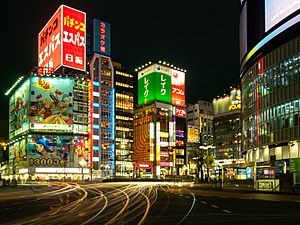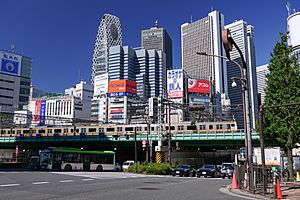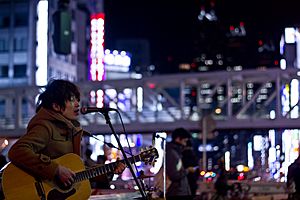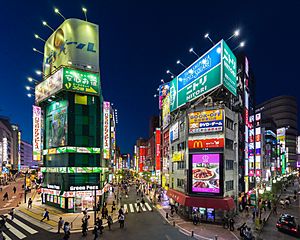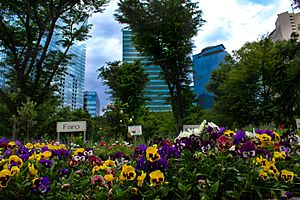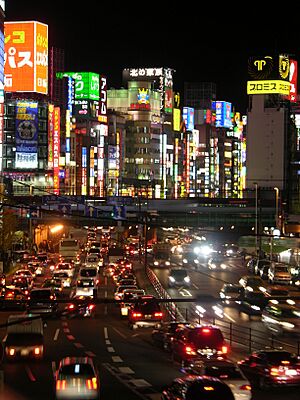Shinjuku facts for kids
Quick facts for kids
Shinjuku
新宿区
|
|||
|---|---|---|---|
| Shinjuku City | |||
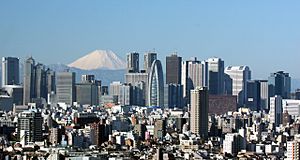
Skyscrapers of Shinjuku with Mount Fuji in the background
|
|||
|
|||
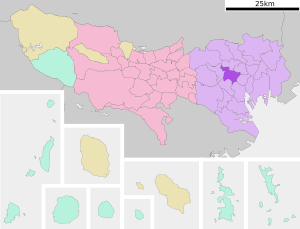
Location of Shinjuku in Tokyo
|
|||
| Country | Japan | ||
| Region | Kantō | ||
| Prefecture | Tokyo | ||
| Area | |||
| • Total | 18.23 km2 (7.04 sq mi) | ||
| Population
(1 October, 2020)
|
|||
| • Total | 349,385 | ||
| • Density | 19,165/km2 (49,638/sq mi) | ||
| Time zone | UTC+9 (Japan Standard Time) | ||
| - Tree | Zelkova serrata | ||
| - Flower | Azalea | ||
| Phone number | 03-3209-1111 | ||
| City Hall Address | Kabukichō 1-4-1, Shinjuku-ku, Tokyo 160-8484 | ||
Shinjuku (Japanese: 新宿区, Hepburn: Shinjuku-ku), officially called Shinjuku City, is a special area in Tokyo, Japan. It's a super important place for business and government. You'll find the northern part of the world's busiest train station, Shinjuku Station, here. It also has the Tokyo Metropolitan Government Building, which is like the main office for Tokyo's government.
As of 2020, about 349,385 people live in Shinjuku. The area is about 18.23 square kilometers. This means it's very crowded, with around 18,232 people living in each square kilometer. Since World War II, Shinjuku has become a huge center in Tokyo, just as important as older areas like Marunouchi and Ginza.
Sometimes, when people say "Shinjuku," they mean the whole area around Shinjuku Station. But the southern part of the station and its surroundings are actually in the Shibuya area.
Contents
Discovering Shinjuku's Past
Let's look back at how Shinjuku grew into the amazing place it is today!
How Shinjuku Began
In 1634, during the Edo period in Japan, a big moat was built around Edo Castle. Many temples and shrines moved to the Yotsuya area, which is now part of Shinjuku. Later, in 1698, a new rest stop called Naitō-Shinjuku was created on the Kōshū Kaidō highway. The name "Naitō" came from a powerful family whose home was in the area. Today, their land is a beautiful public park called Shinjuku Gyoen.
Growing into a City
In 1920, the town of Naitō-Shinjuku became part of Tokyo City. Shinjuku really started to grow after the 1923 Great Kantō earthquake in 1923. This area was mostly safe from the earthquake's damage. That's why West Shinjuku is one of the few places in Tokyo with so many tall skyscrapers.
Sadly, during the Tokyo air raids in 1945, almost 90% of the buildings around Shinjuku Station were destroyed. After the war, Shinjuku was rebuilt, keeping its original street and rail layout. Only the Kabuki-cho area had a big new plan for rebuilding.
Modern Shinjuku Takes Shape
On March 15, 1947, the current Shinjuku area was officially formed. This happened when three older areas – Yotsuya, Ushigome, and Yodobashi – joined together. Shinjuku was even part of the 1964 Summer Olympics, hosting parts of the 50 km walk and marathon races.
In the 1970s, a water treatment plant in the area closed down. This space was then used to build even more skyscrapers. In 1991, the main government office for Tokyo moved to Shinjuku. This made Shinjuku an even more important center for the city.
Exploring Shinjuku's Layout
Shinjuku is surrounded by other parts of Tokyo. To the east is Chiyoda, to the north are Bunkyo and Toshima. To the west is Nakano, and to the south are Shibuya and Minato.
Shinjuku is made up of several unique neighborhoods that have grown together over time.
Key Neighborhoods to Know
- East Shinjuku: This area is east of Shinjuku Station. It's home to the city hall and famous department stores like Isetan.
- Golden Gai: A cool area with many tiny, unique bars and clubs. It's a popular spot for artists and creative people.
- Shinjuku Gyo-en: A huge, beautiful park. It mixes Japanese, English, and French garden styles.
- Shinjuku Ni-chōme: This is Tokyo's most famous LGBTQ+ friendly district.
- Nishi-Shinjuku: West of Shinjuku Station, this area is famous for its many skyscrapers. It has some of Tokyo's tallest buildings, including the Tokyo Metropolitan Government Building.
- Ōkubo: This neighborhood around Okubo Station is known for its Korean community.
- Totsuka: In the northern part of Shinjuku, near Takadanobaba Station and Waseda University. It's a lively area for students.
- Ushigome: A mostly residential area in the eastern part of the city.
- Kagurazaka: A charming hill area once known for its traditional geisha entertainment. Today, it's also famous for its French community.
It's important to remember that the popular "Shinjuku" area around Shinjuku Station actually includes parts of Shibuya too!
Most of Shinjuku is on the Yodobashi Plateau, which is a higher area of land. The Kanda River runs through some parts of Shinjuku at a lower level. The highest point in Shinjuku is Hakone-san in Toyama Park, which is 44.6 meters above sea level.
Shinjuku's Economy
The area around Shinjuku Station is a huge center for business in Tokyo. Many big companies have their main offices or Tokyo branches here.
Major Companies and Stores
You'll find companies like:
- NTT East (a phone company)
- Olympus Corporation (cameras and medical devices)
- Seiko Epson (electronics)
- Square Enix (video games)
- McDonald's Japan and Yoshinoya (fast food)
- Subaru Corporation (cars)
- Nissin Foods (instant noodles)
The station area also has many large stores. These include famous department stores like Isetan and Takashimaya. You can also find big electronics stores like Bic Camera and Yodobashi Camera.
Publishing and Books
Northeastern Shinjuku is a busy place for publishing books and magazines. Companies like Shinchosha and Futabasha are located here. The main store of the Books Kinokuniya bookstore chain is also in Shinjuku.
People Living in Shinjuku
| Resident Nationalities | |
| Nationality | Population (Percentage) (2018) |
|---|---|
| 301,163 (87.8%) | |
| 13,060 (3.8%) | |
| 10,006 (2.9%) | |
| 3,716 (1%) | |
| 3,368 (0.98%) | |
| 2,211 (0.64%) | |
| Others | 12,711 (3.88%) |
Shinjuku is a very diverse place! As of 2017, it had the highest number of non-Japanese citizens living there compared to other areas in Japan. By 2012, people from China became the largest group of foreign citizens in Shinjuku. Before that, people from North and South Korea were the most common foreign citizens.
Government and Leadership
Shinjuku is a "special ward" of Tokyo. This means it has a status similar to a city.
Local Government
The current mayor of Shinjuku is Kenichi Yoshizumi. The local council, called the kugikai, has 38 elected members. The Liberal Democratic Party and New Komeitō Party together hold most of the seats. Other parties like the Democratic Party of Japan and the Japanese Communist Party also have members. The main office for Shinjuku City is located near Kabukichō.
Tokyo's Main Office
Shinjuku is also where the Tokyo Metropolitan Government is located. The governor's office and the main assembly hall are in the Tokyo Metropolitan Government Building. This technically makes Shinjuku the capital of Tokyo Prefecture. However, for general purposes, the entire area of the 23 special wards of Tokyo is often considered the capital.
Getting Around Shinjuku
Shinjuku is a super important place for transportation. Shinjuku Station is known as the busiest station in the world! About 3.64 million passengers pass through it every single day. It connects to many subway lines and private train lines, as well as several JR lines.
Train and Subway Lines
Many train and subway lines run through Shinjuku, making it easy to get anywhere. Some of the main lines include:
- JR East: Yamanote Line, Chūō Line (Rapid), Chūō-Sōbu Line, Saikyō Line, Shōnan-Shinjuku Line
- Tokyo Metro: Marunouchi Line, Yūrakuchō Line, Tōzai Line, Fukutoshin Line, Namboku Line
- Tokyo Metropolitan Bureau of Transportation: Toei Shinjuku Line, Toei Ōedo Line, Toden Arakawa Line
- Private Lines: Odakyu Electric Railway Odawara Line, Keio Corporation Keio Line, Keio New Line, Seibu Railway Seibu Shinjuku Line
Major Roads
Shinjuku also has important roads for cars and buses:
- Shuto Expressway: Routes No.4 Shinjuku and No.5 Ikebukuro
- National Route 20 (also known as Shinjuku-dōri and Kōshū-kaidō)
- Other major routes like Tokyo Metropolitan Route 8 (Mejiro-dōri) and Tokyo Metropolitan Route 302 (Yasukuni-dōri).
Learning in Shinjuku
Shinjuku is home to many great schools and universities.
Universities and Colleges
You can find several well-known universities here, including:
- Chuo University (graduate school)
- Keio University (Medical College)
- Kogakuin University
- Tokyo Medical University
- Tokyo University of Science
- Waseda University
High Schools
There are public high schools run by the Tokyo Metropolitan Government, such as:
- Shinjuku High School
- Shinjuku Yamabuki High School
- Toyama High School
Many private high schools are also located in Shinjuku, like Gakushuin Girls Junior and Senior High School and Waseda Junior and Senior High School.
Elementary and Junior High Schools
Public elementary and junior high schools in Shinjuku are managed by the Shinjuku City Board of Education.
Public Places and Fun Spots
Shinjuku has many public places for everyone to enjoy.
Libraries
There are several public libraries in Shinjuku, including the Central Library, which has a special section just for children!
Hospitals
Shinjuku has many large hospitals, such as:
- Keio University Hospital
- Tokyo Medical University Hospital
- Tokyo Women's Medical University Hospital
Museums and Cultural Centers
If you love learning and art, Shinjuku has some cool places to visit:
- National Printing Bureau Banknote and Postage Stamp Museum (learn about money and stamps!)
- Shinjuku Historical Museum (discover Shinjuku's past)
- Tokyo Toy Museum (a fun place for all ages)
- Tokyo Opera City (a big hall for performances)
Sister Cities
Shinjuku has special "sister city" friendships with other places around the world:
Famous People from Shinjuku
Many notable people were born or lived in Shinjuku, including:
- Shinzo Abe, a former Prime Minister of Japan
- Ichirō Hatoyama, another former Prime Minister of Japan
- Takuma Sato, a professional racing driver
- Kōichi Satō, a famous actor
- Jun Togawa, a singer and musician
Images for kids
-
Shinjuku Gyo-en National Garden and NTT DoCoMo Yoyogi Building
See also
 In Spanish: Shinjuku (Tokio) para niños
In Spanish: Shinjuku (Tokio) para niños
- Citizens' Plaza, an urban space in Shinjuku
- Tourism in Japan





